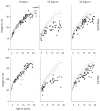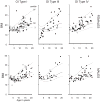Growth characteristics in individuals with osteogenesis imperfecta in North America: results from a multicenter study
- PMID: 29970925
- PMCID: PMC6320321
- DOI: 10.1038/s41436-018-0045-1
Growth characteristics in individuals with osteogenesis imperfecta in North America: results from a multicenter study
Abstract
Purpose: Osteogenesis imperfecta (OI) predisposes people to recurrent fractures, bone deformities, and short stature. There is a lack of large-scale systematic studies that have investigated growth parameters in OI.
Methods: Using data from the Linked Clinical Research Centers, we compared height, growth velocity, weight, and body mass index (BMI) in 552 individuals with OI. Height, weight, and BMI were plotted on Centers for Disease Control and Prevention normative curves.
Results: In children, the median z-scores for height in OI types I, III, and IV were -0.66, -6.91, and -2.79, respectively. Growth velocity was diminished in OI types III and IV. The median z-score for weight in children with OI type III was -4.55. The median z-scores for BMI in children with OI types I, III, and IV were 0.10, 0.91, and 0.67, respectively. Generalized linear model analyses demonstrated that the height z-score was positively correlated with the severity of the OI subtype (P < 0.001), age, bisphosphonate use, and rodding (P < 0.05).
Conclusion: From the largest cohort of individuals with OI, we provide median values for height, weight, and BMI z-scores that can aid the evaluation of overall growth in the clinic setting. This study is an important first step in the generation of OI-specific growth curves.
Keywords: Growth; Height; Natural history study; Osteogenesis imperfecta; Weight.
Figures




References
Publication types
MeSH terms
Substances
Grants and funding
LinkOut - more resources
Full Text Sources
Other Literature Sources
Medical

